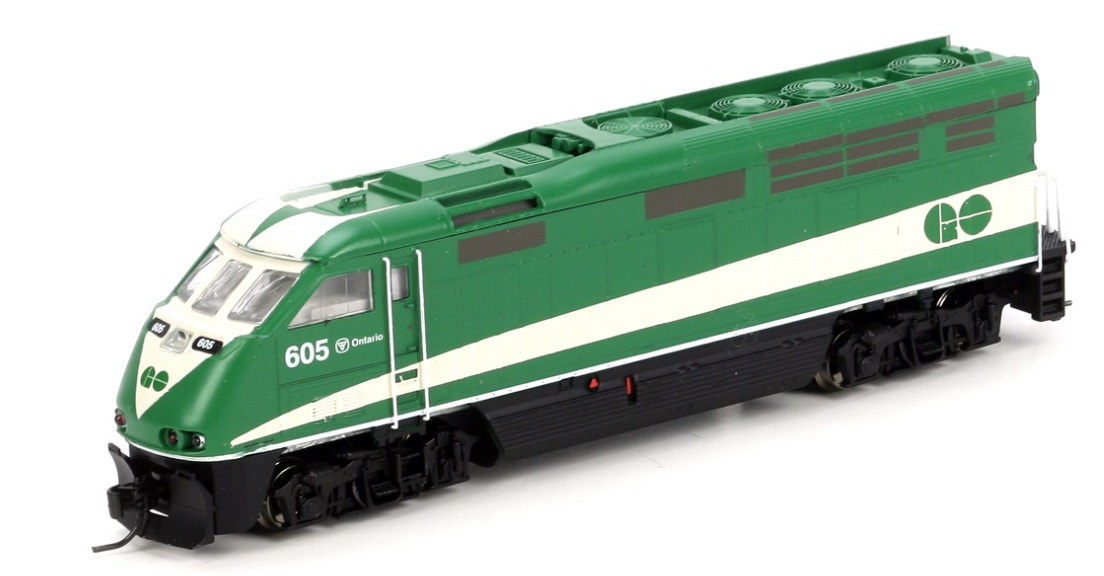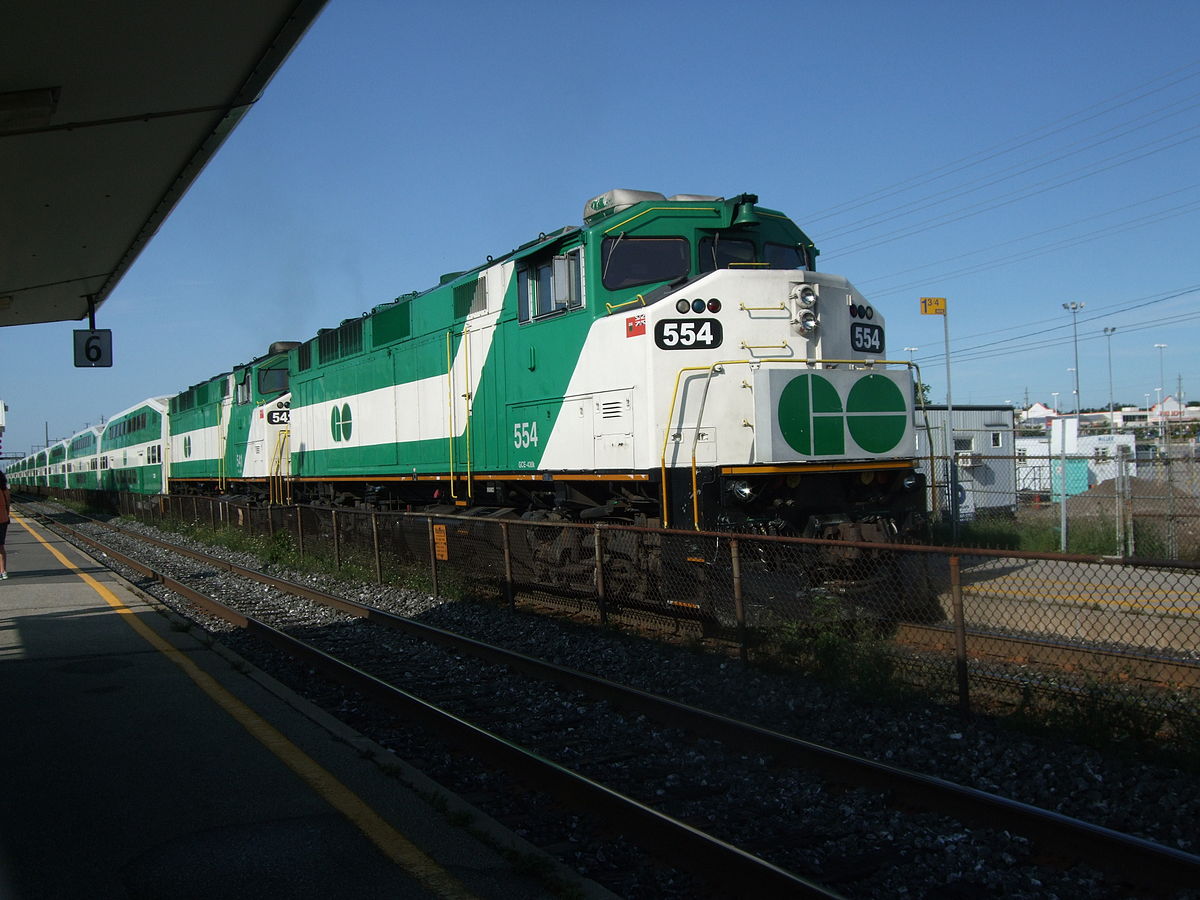Athearn EMD F59 Series – GO Transit F59PHI: Worthwhile Buy
Published: 2018-12-21 - By: Powderman
Last updated on: 2021-08-12
Last updated on: 2021-08-12
visibility: Public - Headline


The F59PHI made in Korea in 2003 was Athearn’s first ever n-scale release. These locos were okay, but noisy and difficult to convert to DCC.
Athearn improved on these models with subsequent releases, which were manufactured in China. In June 2010, it announced the EMD F59PHI; this was the second model of their F59 Commuter/Passenger engine. The third release was announced in April 2016 and delivered in May of 2018.
Both releases are available in DC, DCC-no sound or DCC with sound. They are available in various paint schemes: Amtrak/Surfliner, Amtrak/California, Amtrak/West, Amtrak/Operation Lifesaver, Amtrak/10th Anniversary and Amtrak/Surfliner.
Both models are available in many road names and numbers: Cal Train, Metrolink, GO Transit, Sounder, Coaster, West Coast Express, Northstar, NMDOT, Utah Front Runner, PRR, SF, SOU, SP, RailRunner, Florida Tri-Rail and Trinity Rail Express.
Click here to see all the Athearn F59PHIs on TroveStar
The Prototype

The original F59PH was commissioned by GO Transit in the late 80s from EMD. The 3000-hp passenger locomotive was powered by a 12-cylinder engine along with an independent HEP engine-generator set housed in a full-cowl CN-style comfort cab. The train was so popular with commuters that it became a winner on the west coast with MetroLink ordering dozens of the design. A total of 73 were built between 1988 and 1994.
The California-modified F59, now called the F59PHI, replaced the F59PH in the mid 1990s. Some 83 were built between 1994 and 2001. The engine delivered 3000-hp (like the base F59PH) but a with full-cowl car body, a streamlined cab with fiberglass nose and weighed in at 8,000 pounds, which was heavier than the original.
The F59PHI was not Tier 2 compliant thus the next style adopted by GO Transit became the Motive Power MP series. Since the introduction of EPA Emissions Regulations in the mid-1990s, nonroad diesel emissions have been dramatically reduced. This has been accomplished in a four steps (tiers). With virtually zero emissions when Tier 4 was achieved in 2015.
GO did not have any F59PHIs but transitioned from F59PH to MP40PH-3s. GO locomotive 600 to 666 are MP40PHs not F59PHIs as modeled by Athearn.
Review of both the 2010 (#605) and 2018 (#665) releases (DC versions)
The Athearn product models the F59PHIs, which if you examine the GO road numbers, are not the GO F59PHIs but are GO MP40s . They are a good stand-ins if you want GO livery.
LOCOMOTIVE FEATURES:
- Non-sound locomotives are DCC ready
- Accurately painted and printed, more on this later
- Highly detailed, injection molded body
- See through cab windows
- McHenry operating knuckle couplers
- Bi-directional constant LED lighting so headlight brightness remains consistent
- All-wheel drive with precision gears for smooth and quiet operation
- All-wheel electrical pickup provides reliable current flow
- Heavy die-cast frame for greater traction and more pulling power, both test units weigh in at 109 grams
- 5-pole skew wound motor with weighted and balanced flywheels
- Multi-link drive train for trouble free operation
- Clear plastic jewel box for convenient storage
- Operates on Code 55 rail and Code 80 rail
- Minimum radius: 9 3/4"
SOUND EQUIPPED LOCOMOTIVES ALSO FEATURE:
- Onboard DCC decoder with SoundTraxx Tsunami decoder
- Sound units operate in both DC and DCC
- Some functions are limited in DC
- Engine, horn, and bell sounds work in DC
- All functions NMRA compatible in DCC mode
- Slow speed control
- Program a multiple unit (MU) lash up with lead unity only horn, bell, and lights
- Many functions can be altered via Configuration Value (CV) changes
- CV chart included in the box
Both units reviewed are non DCC nor Sound equipped, please see the discussion below. The 2011 release listed at around $100 and the 2018 release listed at $115.
High-Quality Details and Paint Job
The detail and painting on the second release (#605 – 23701) is representative of the prototype. However, the white paint is more beige than white. The GO green, which covers most of the sides and the entire roof, looks good. The painted-on red lights located low on the forward cowl are a little sloppy. The glued-up joints between sections are quite crisp. The body detail is nicely done. The GO Transit emblem and the Ontario Trillium are sharp.
The detail and painting on the third release (#665 – ATH15251) is representative of the prototype. More of the body has white, which appears to be the true white. The body shares two greens, the GO green and a lighter apple green on the lower portion. The roof detail is identical to #605 but it is now painted black. There is also a silver band on each side at the deck. The red lights on the forward look great. The glued-up joints between sections is not as crisp as on the #605. The body detail is nicely done with additional graphics such as the “F” on the coupler side support. Another detail addition is the painted directional light on the back below the deck. The GO Transit emblem and the METROLINX are crisp. The rear guard white handrails are large which is a bit out of scale on both models. The side skirts are lightly detailed but have red, which highlights the fuel cap and level.
Smooth Performance
The units perform smoothly with a good slow speed and a fast speed, needed for a commuter train. They can easily pull five or six Athearn Bi Level Commuter cars.
The minimum radius is about 9 3/4” but they will look better when pulling commuter cars on larger radius curves.
Better performance is anticipated if they are DCC equipped. There has been much discussion on Model RR forums if DCC engines run better. It could possibly be to the adjustability of the top speeds and the throttle response. Full voltage on the tracks helps for continuity of operations especially at slow speeds.
Both units are non-DCC nor Sound equipped, please see the discussion below.
Converting to DCC or DCC Sound
I would like to thank Alain LM, a curator at TroveStar, for this insight. He has written some excellent blogs.
The OEM Tsunami sound decoder that comes with factory equipped F59 or F45/FP45 is not sold as a separate item. Although there is some discussion on nscale.net (Alternative-Sound-Decoder-for-Athearn-F59PHI?) that you could buy one for $95 from Athearn.
The F59PHI may share the same boards as the Athearn F45/FP45; Alain assumed that the following might fit, though not without some adjustments.
Digitrax DN163K1C: Chassis requires that the decoder be installed backwards. This will cause the headlights to light in the opposite direction. NDOT (NDOT - Normal Direction of Travel) needs to be changed. To change the NDOT, increase the value of the CV29 by one. For example, if CV29=038 change the value to 039. This is similar to the DN163K4A meant for the Kato Glacier Express but also fits the Kato SDF40F, but backwards.
Digitrax SDN144K1E: Possible Frame Modification Required Chassis requires that the decoder be installed backwards, the same as above. The speaker installation is easier since the speaker is 13 mm whereas the housing in the locomotive frame allows for a 20 mm speaker. Care will be needed to stick the smaller speaker in place to avoid rattle or movement.
The power pick-up will only be performed at the extremity, as the middle power pads do not match the analog board. The motor legs will probably need to be unsoldered from the analog board and then attached to the new boards.
The Digitrax boards are slightly longer than the analog board: 3.11" vs. 3.0" so the fit up will have to be checked with the shell on. Some modification may be necessary. The width should be no problem since there is a little slack with the factory board in the frame.
Well, you could give it a try with the non-sound decoder. And if it doesn't fit, save it for a Kato SD40-2!
Conclusion

This model is a very good representation of the GO engines even though not prototypical. They run well and can be easily converted (with the right aftermarket decoder board) to DCC. The frames have a cavity that will allow for a speaker to be added if you want to upgrade to DCC Sound.
Credits
The copyright of this article is held by the author Powderman, who is granting TroveStar with right to display it. Except where otherwise mentioned, all images are copyrighted by the author.

